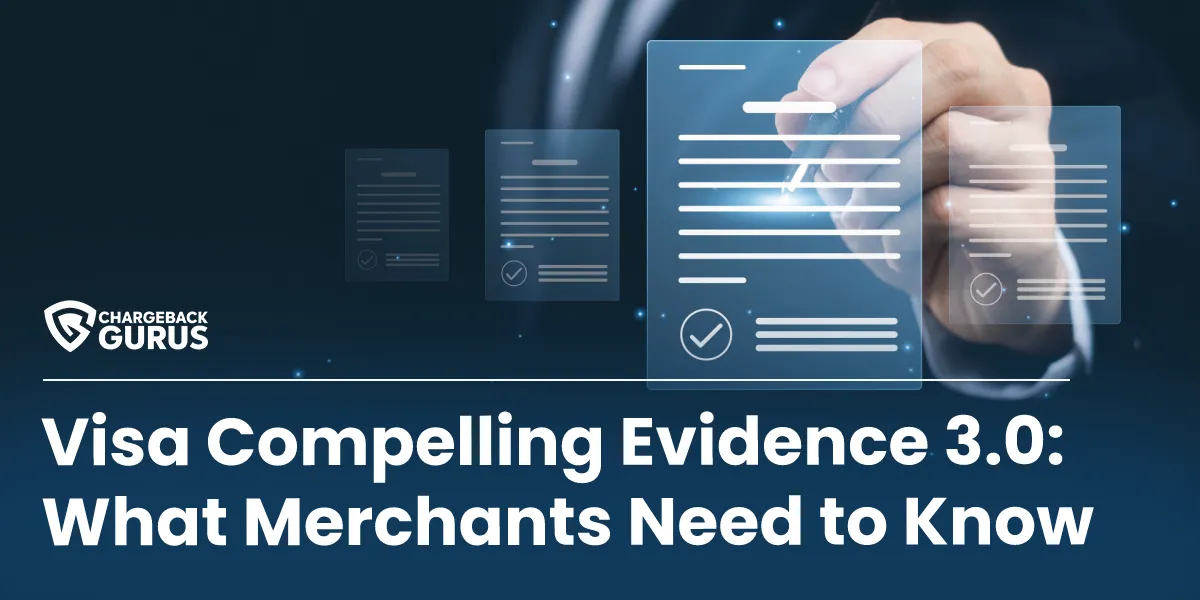Compelling Evidence
Table of Contents
- What Constitutes Compelling Evidence for a Chargeback?
- Chargeback Evidence for Retail Merchants
- Chargeback Evidence for E-commerce Goods
- Chargeback Evidence for Digital Goods and Subscriptions
- Chargeback Evidence for Travel and Hospitality Merchants
- Fight Chargebacks With Experience
- How Do You Win a Chargeback?
- Are There Chargeback Fees?
- How Many Chargebacks Can Merchants Have?
No merchant enjoys being on the receiving end of a credit card dispute. You lose the sale, you often lose the product, and you have to pay a chargeback fee as well. You don't always have to just accept these losses, however. Most chargebacks are illegitimate, and illegitimate chargebacks can be reversed. In order to achieve this, you'll need to gather compelling evidence that the transaction was valid and authorized. You'll also need to prove that you fulfilled your end of the sales agreement and the cardholder got what they paid for.
Unfortunately, what constitutes compelling evidence varies. The card networks have different rules for different types of merchants, and each chargeback reason code has its own standards for what evidence is needed to overturn it. In addition, the same evidence that one bank finds compelling can sometimes be seen as insufficient by another. What do merchants need to know in order to win disputes with compelling evidence?
 When a merchant decides to fight a chargeback, they enter a phase called representment, which is a literal re-presenting of the transaction with evidence to support it. When the issuing bank reverses a transaction, the funds are taken from the merchant's account right off the bat. In order to get that money back, it's up to the merchant to then resubmit that transaction with evidence proving that it was legitimate.
When a merchant decides to fight a chargeback, they enter a phase called representment, which is a literal re-presenting of the transaction with evidence to support it. When the issuing bank reverses a transaction, the funds are taken from the merchant's account right off the bat. In order to get that money back, it's up to the merchant to then resubmit that transaction with evidence proving that it was legitimate.
What Constitutes Compelling Evidence for a Chargeback?
The reason code indicates what justification the customer gave when they disputed the charge. If the merchant can demonstrate that the facts of the transaction don't support the customer's claim, the issuing bank will usually reverse the chargeback.
For example, If the customer claims that their card was stolen, the merchant should submit any and all evidence they have showing that the purchase was in fact made by the cardholder. If the customer claims that they never received their purchase in the mail, your evidence package should focus on shipping information.
Documents commonly submitted as compelling evidence include:
- Receipts of purchase, especially if those receipts have signatures.
- Shipping records and delivery confirmation.
- IP address information.
- Correspondence with the customer.
- Records of any other identity verification methods used.
There is no magic bullet for evidence, however. Different issuing banks may have different expectations for what evidence a merchant should provide, and may prefer certain forms of evidence over others.
As you might imagine, some chargebacks are easier to provide evidence for than others, and merchants should make an effort to judge the strength of the evidence they can actually submit before deciding to fight a chargeback.
For example, consider a chargeback where the customer claims they didn't make the purchase. If the merchant has records showing the purchase was made from the same computer and shipped to the same location as previous purchases, it should be an easy win.
On the other hand, chargebacks where the customer claims the product was damaged in shipping can be much harder to reverse, since the merchant will often have no evidence to disprove that claim.
Next, let's go over some examples of what evidence different types of merchants might need to submit in representment.
Chargeback Evidence for Retail Merchants
For retail merchants operating out of brick and mortar stores, chargebacks are often high in value, frequently resulting from buyer’s remorse after the purchase. In order to dispute these chargebacks and recover your lost revenue, you’ll need to produce evidence disproving the customer's claims about the transaction or the product.
This evidence may include:
- A scanned copy of the customer’s photo ID
- An invoice
- A transaction receipt
For retail merchants, the advent of the EMV chip has made fraud-related chargebacks much less of a concern, at least for those in compliance. If the merchant scanned the EMV chip and followed all other payment processing rules, they won't be held liable for claims of fraud.
If the merchant processed the transaction without using the card's EMV chip, however, they will automatically be assigned liability for any fraud claim. This makes EMV compliance the single most impactful thing retail merchants can do to prevent chargebacks.
Chargeback Evidence for E-commerce Goods
For e-commerce merchants selling and shipping tangible goods and products, the main goal is to produce evidence that proves the customer received the goods and may have even used them. The absolute best piece of evidence you can provide for these chargebacks is a signed proof of delivery.
Here are just a few of the types of evidence you may want to provide, if available:
- Proof of delivery, ideally signed by the customer
- Copies of any and all customer service communications
- AVS & CVV match
- Photos showing the customer using the product (on social media, etc.)
- Your rebuttal letter
E-commerce merchants should always use Address Verification (AVS) and CVV matching to prevent online credit card fraud. This can go a long way when fighting future chargebacks.
 To prevent and fight chargebacks associated with account takeover fraud, consider using two-factor authentication. Customers can be required to set up two-factor authentication using a phone number or authenticator app. If that seems too heavy-handed, you can provide a small reward for customers who do so.
To prevent and fight chargebacks associated with account takeover fraud, consider using two-factor authentication. Customers can be required to set up two-factor authentication using a phone number or authenticator app. If that seems too heavy-handed, you can provide a small reward for customers who do so.
You can also simply require the customer to click a link sent to the email address they signed up with whenever they access their account from a new device.These methods do add friction in some cases, but they also prevent fraud and provide valuable evidence to fight illegitimate chargebacks.>
Chargeback Evidence for Digital Goods and Subscriptions
E-commerce merchants that sell digital goods or subscriptions typically have the biggest challenge when it comes to producing compelling evidence – simply because it’s difficult to prove the product was actually delivered.
If you operate in this industry, the best piece of evidence you can offer is an IP match verifying that the customer’s IP address matches the address associated with the credit card used on the transaction.
You may also be able to use that IP address to show they logged into your system to download or use a product.
All in all, potential evidence for digital goods merchants includes:
- AVS & CVV match
- IP address match
- Location data
- Copies of any emailed invoices
- Copies of all customer service communications
- Proof of usage, ideally with IP addresses
- The terms and conditions the customer agreed to at the time of purchase
- Your rebuttal letter
Chargeback Evidence for Travel and Hospitality Merchants
For travel agencies, ticketing merchants, hotels, and vacation rentals, showing an AVS and CVV match is crucial with online transactions, while voice authorizations are the key for phone sales.
Copies of check-in details and other communications can also be helpful pieces of evidence on ticketing and travel chargebacks.
In general, the best types of evidence in travel chargebacks include:
- AVS & CVV match
- Voice authorization
- Copies of tickets and check-in confirmations
- Confirmation of familial connections (often via social media, if family fraud is suspected)
- The terms and conditions the customer agreed to at the time of purchase
- Your rebuttal letter
Fight Chargebacks With Experience
It’s important to note that these are just general guidelines. Every chargeback dispute is different and requires custom-fit evidence to prove your case. Also keep in mind that every card network has different rules, regulations, and processes, and following these is vital if you want to see success.
In order to fight chargebacks and recover lost revenue, you must first understand how chargebacks are filed and how the dispute process works.Our guide, The Smart Way to Fight & Recover Chargebacks, will help you to fight and recover your chargebacks the smart way.
Fighting chargebacks only gets easier with experience, but if you don't have experience of your own to lean on, you can always take advantage of those who do. A good chargeback management firm will have employees with years of experience who will fight chargebacks on your behalf to ensure you recover as much revenue as possible.
FAQ
How Do You Win a Chargeback?
Are There Chargeback Fees?
How Many Chargebacks Can Merchants Have?
Thanks for following the Chargeback Gurus blog. Feel free to submit topic suggestions, questions or requests for advice to: win@chargebackgurus.com










